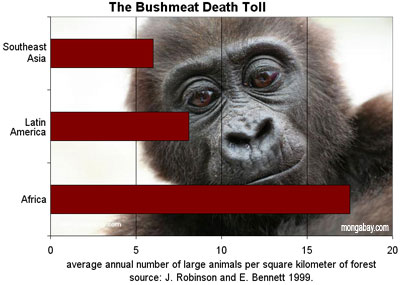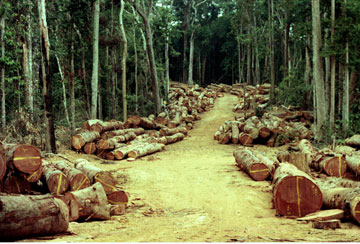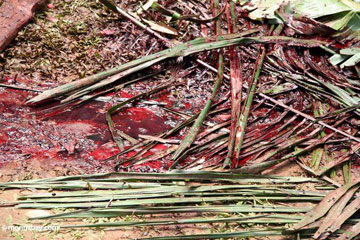New studies show ecological impact of the loss of rainforest animals to the bushmeat trade
Commercial hunting is decimating wildlife populations across the tropics and may be one of the gravest threats presently facing rainforests, reports a series of studies published in the May issue of the journal Biotropica. The research reveals that large-scale loss of wildlife is already affecting forest health and regeneration.
Historical context
Humans have long hunted wild game from forests, but over the past 50 years commercialization of killing has triggered a rapid increase in wildlife depletion.
Reviewing a comprehensive set of studies on the impact of hunting in Southeast Asia, Dr. Richard Corlett, a biologist at the University of Hong Kong, found that mass extinction of large animals is a real threat in the region. He says that while man has hunted wildlife in Asian forests for at least 40,000 years, to date there has been only a single confirmed global extinction—the giant pangolin, a scaly ant-eating beast that once roamed the jungles of Southeast Asia. However, this may not be the case for long.

Southeast Asia (2 studies), 17.5 animals in Africa (2 studies), and 8.1 animals in Latin America (5 studies) according to data derived from J. Robinson and E. Bennett, Eds., Hunting for Sustainability in Tropical Forests (Columbia University Press, New York, 1999). Chart and photo of a young gorilla in Gabon by Rhett A. Butler. |
“There is no strong evidence for unsustainable hunting pressure until the last 2,000-3,000 years, when elephants, rhinoceroses, and several other species were progressively eliminated from large parts of their ranges,” he writes. “Over the last 50 [years], the importance of hunting for subsistence has been increasingly outweighed by hunting for the market. The hunted biomass is dominated by the same species as before, sold mostly for local consumption, but numerous additional species are targeted for the colossal regional trade in wild animals and their parts for food, medicines, raw materials, and pets.”
Historically, the situation in only slightly better in Africa, where about three-fifths of large mammals are being harvested in the Congo Basin at rates that threaten their existence, according to Dr. Carlos A. Peres of the University of East Anglia in Britain and Dr. John Fa of the Durrell Wildlife Conservation Trust in Jersey,
By comparison, the situation in the Amazon is better than in both Asia and Africa, though research by Dr. Peres and Dr. Erwin Palacios of Conservation International in Colombia indicates that hunting pressure in the Amazon is often underestimated and wildlife density is fast-thinning, even in remote and protected areas. Large species are the first to go.
 These rough estimates, showing that millions of animals are killed each year in Africa, Asia, and the Amazon for subsistence hunting and the bushmeat trade, are extrapolated from J. Robinson and E. Bennett (1999) data, forest cover figures from the U.N. Food and Agricultural Organization for 2005, and numbers in J. Robinson and K. Redford, Eds., Neotropical Wildlife Use and Conservation (University of Chicago Press, Chicago, IL, 1991);. The numbers include mammals, birds, and reptiles. Estimation, chart and photo of a red howler monkey in Colombia by Rhett A. Butler. Please note that these are only rudimentary estimates — there are presently no reliable projections for the number of animals hunted each year. |
“This is the most robust, comprehensive, large-scale meta-analysis on the effects of subsistence hunting on game vertebrate populations ever conducted for a large tropical forest region,” Peres told mongabay.com via e-mail. “The analysis clearly shows that hunting-mediated population declines in harvest-sensitive vertebrate species are far worse than we previously thought.”
“The total extent of partially defaunated, but otherwise ‘pristine’ tropical forests, is often severely underestimated. For example, subsistence hunters have access to most areas of lowland Amazonia, affecting even the core of many relatively remote nature and indigenous reserves,” Peres and Palacios report. “Only 1.6 percent of Brazilian Amazonia is both strictly protected on paper and inaccessible to game hunters…. Most large game birds and mammals have been severely reduced to a small fraction of their original population densities, often just 1 to 5 percent of the densities of the same species in similar protected forests.”
Factors amplifying wildlife depletion
Dr. S. Joseph Wright, a scientist with the Smithsonian Tropical Research Institute in Panama, and his colleagues say several factors contribute to the overexploitation of forest game, including economics, improved infrastructure, the emergence of regional and international markets, and new technology.
“The weak economies of many tropical countries fail to provide sufficient jobs for their growing populations, while land-use change, improved infrastructure, and new technology facilitate commercial hunting,” they write. “Land-use change brings hunters and their markets closer to previously remote forests. Improved infrastructure provides access to forest interiors over roads opened for timber and mineral extraction as well as access to distant urban markets.”
“The new technologies include guns, wire snares, battery-powered lights, and motorized transport and have largely replaced traditional hunting technologies even among indigenous peoples. Collectively, land-use change, improved infrastructure, and new technologies increase the return for time spent hunting and make it possible for hunters to deplete their prey to lower levels. These factors combine to create the pantropical ‘wild meat’ or ‘bushmeat’ crisis today,” the authors add.
In Asia, says Dr. Corlett, market pressure on wildlife is particularly intense.

Logging roads are contributing to the bushmeat trade in the Congo and other parts of the world. Photo by Richard Ruggiero of WCS. From Congo forest elephants declining from logging roads, illegal ivory |
“The other major driver of increasing hunting pressure has been the development of markets and associated trade routes for almost any mammal that can be captured. The range of species involved seems to be a unique feature of Asian wildlife markets, and the trade has strong cultural underpinnings on both the supply and demand sides,” he writes. “The demand for luxury food and nonfood animal products comes largely from an increasingly wealthy urban market, able to pay high prices and willing (if often unwittingly) to accept substitutes when a previously preferred species is extinct. This sort of pressure has the potential to strip forests of almost all mammal species.”
Corlett adds that forest fragmentation has made it easier to exploit game while population growth has driven demand.
“The major change over this period has been the increased accessibility of the remaining forests to hunters and their markets, as a result of forest fragmentation, population growth, and improved infrastructure. By the 1990s, less “frontier forest”—large, more or less intact, natural forest ecosystems—survived in tropical Asia than elsewhere in the tropics, and many countries in the region (China, India, Laos, Vietnam, and the Philippines) had already lost 98-100 percent.”
He says that Indonesia, the country that has the largest remaining area of frontier forest, has “suffered massive deforestation” in the past decade and that much of the forest that has not been cleared has been logged, “resulting in both a temporary increase in hunting pressure to provide meat for logging camps and a permanent increase in accessibility.”
The trends for wildlife are not favorable.
Ecological implications of “half-empty” forests
The impact of “defaunation” on tropical forest ecology is significant, affecting seed dispersal and predation, which, in turn, alter the species balance and dynamics of the forest. Five papers in the special section of Biotropica examine these effects: two of them look at the impact of hunting for seed dispersal, while the others examine the significance of wildlife loss for seedling and sapling species composition.
Corlett provides an illustration showing the impacts caused by the disappearance of fruit-eating species.
 Despite a multi-decade ban on lemur-hunting in Madagascar, the primates are still trapped and shot in remote areas. Photo by Rhett A. Butler. |
“All the major dispersal agents of large fruits in the Oriental region—large birds, primates, large fruit bats, civets, and terrestrial herbivores—are hunted, and many species have now been eliminated from most of their natural ranges. The only mammalian frugivores that thrive in human-dominated landscapes are some small fruit bats,” he writes. “Birds cannot compensate for the loss of mammals in such landscapes, even for fruit species consumed by both groups, because only small-gaped bird species survive.”
Similarly, Peres and Palacios suggest that widespread hunting of frugivores in Amazonian forests may “produce a collapse of seed-dispersal services for dependent plant species” in some areas, altering plant community composition.
Summarizing the five papers, Wright and colleagues write that the research demonstrates “that hunting has pervasive effects on tropical forest plant communities altering levels of predispersal seed predation, primary and secondary seed dispersal, and postdispersal seed predation, which, in turn, alter seedling and sapling species composition.”
“A discouraging possibility is that plant species composition might shift to a new steady state with crucial plant species absent or at such low numbers that animals fail to recover,” they warn.
Solving the bushmeat crisis
 Wild bearded pig in Borneo. Pigs are widely hunted in Indonesia.
|
Even as the bushmeat crisis mounts, the researchers are hopeful.
Corlett believes that one of the keys to addressing unsustainable hunting is to first acknowledge that it is a threat.
“I think the main message is that conservationists in tropical Asia—particularly Southeast Asia—have not given sufficient attention to hunting,” he told mongabay.com via e-mail. “The focus has been first on the admittedly horrendous rate of forest loss and secondly on logging. However, much of the remaining forest, protected or not and logged or not, has lost most or all of its large mammals. We need to solve the hunting problem in existing protected areas, rather than adding more “paper parks.” This is going to require action at both ends—enforcement in the forest and control of the local and regional trade in wild animals and their parts that fuels it. I think this is do-able.”
“WWF’s ‘Heart of Borneo’ project is a good example of a plan that does not seem to give adequate attention to hunting. If Malaysia cannot protect the fauna of the most botanically diverse forest in the world at Lambir, what hope is there for the interior of Borneo?”
While noting that most hunting in Southeast Asia is illegal but that law enforcement is currently weak, Corlett says there are examples “that hunting impacts can be greatly reduced where there is sufficient political will.”
Wright and his colleagues agree.
“It is now widely recognized that the sustainable harvest of wildlife is incompatible with the persistence of large-bodied, slow-reproducing forest vertebrates… While there may be short-term gains for hunters in overharvesting wildlife, these gains are not enough to permanently lift them out of poverty,” they write. “A range of actions has been suggested to reduce the impact of hunting on tropical forest vertebrate communities… but only enforcement has the potential to act fast enough to prevent the regional, and in some cases global, extinction of the most vulnerable species.”
The authors say the top priority should be controlling the trade of wildlife products on the local, regional, and global scale. They highlight the launch of the ASEAN (Association of Southeast Asian Nations) Wildlife Law Enforcement Network as “a step in the right direction.”
Operating on the premise that controlling hunting will be easier if demand is reduced, Wright and his colleagues argue that education and awareness campaigns can help cut demand for wildlife products. They say that zoos should be enlisted in the effort, though the greatest gains will come from involving local people in conservation by hiring former hunters as rangers, guides, and research assistants. This will help local people see forest wildlife as a recurring source of income —far more than just a meal —and help build support for conservation initiatives that protect wildlife and ecosystems.
“The control of hunting and trade in wildlife should be the first priority for governments, NGOs, and individual conservationists in tropical and subtropical Asia. Reductions in deforestation and logging, and the establishment of new protected areas, are all urgently needed, but without a drastic reduction in hunting pressure, they will not be enough to save the region’s large mammal fauna from extinction. Unless immediate action is taken, the megafaunal extinctions that have eliminated half the world’s mammalian genera—45 [kilograms] over the last 50,000 [years]—will have been merely postponed in tropical Asia,” concludes Corlett.
Related articles
Roads tied to bushmeat hunting in Africa
A new study ties the presence of roads to bushmeat hunting in the Congo rainforest and also raises important questions for global conservation. The study, published in the current edition of Conservation Biology, found that roads and associated hunting pressure reduced the abundance of a number of mammal species including duikers, forest elephants, buffalo, red river hogs, lowland gorillas, and carnivores. The research suggests that even moderate hunting pressure can significantly affect the structure of mammal communities in central Africa.
Are Brazil nuts really sustainable?
A lot of rainforest conservation initiatives embrace sustainably harvested non-timber forest products (NTFPs) like seeds and nuts as a means to provide income to locals without harming the forest. Operating on the premise that such products are eco-friendly, hundreds of outfits ranging from Whole Foods to the Body Shop to Ben & Jerry’s Homemade Ice Cream tout their use of sustainably harvested Brazil nuts and related products. But really, how sustainable are these products?
Lemur hunting persists in Madagascar, rare primates fall victim to hunger
We have stumbled upon a series of traps within Masoala National Park, which holds one of the most biodiverse forests on Earth. In these forests you’ll find about 50% of Madagascar’s species, despite their making up less than 2% of its land mass. Given the incredible biological richness the Indian Ocean island, finding these traps is particularly sobering. It reminds us that no matter how much land is protected in Madagascar the only way to preserve its rare and unusual species is to ensure that conservation provides immediate and ongoing benefits for local people.
Thousands of elephants killed for resurgent ivory market in China
Thousands of African elephants are being killed for their ivory tusks, according to a new study led by a biologist from the University of Washington. In a paper published in the online edition of the Proceedings of the National Academy of Sciences, Dr. Samuel Wasser, director of the University of Washington Center for Conservation Biology, shows that elephants are being slaughtered at the highest rate since the international ban on the ivory trade took effect in 1989.
Bushmeat from African apes sold in American markets.
Bushmeat from wild primates in Africa is ending up on plates in North America and western Europe according to an article published in the current issue of New Scientist. Justin Brashares, a wildlife biologist at the University of California at Berkeley who carried out a survey of clandestine markets in seven major cities, says that “the meat, which includes chimpanzee and gorilla parts, makes up nearly a third of the illegal international trade in bushmeat killed in Africa.”
References
- BECKMAN, N., AND H. C.MULLER-LANDAU. 2007. Differential effects of hunting on pre-dispersal seed predation and primary and secondary seed removal of two Neotropical tree species. Biotropica 39: 328-339.
- CORLETT, R. T. 2007. The impact of hunting on the mammalian fauna of tropical Asian forests. Biotropica 39: 292-303.
- DIRZO, R., E.MENDOZA, AND P. ORT´IZ. 2007. Size-related differential seed predation in a heavily defaunatedNeotropical tropical rain forest. Biotropica 39: 355-362.
- MULLER-LANDAU, H. C. 2007. Predicting the long-term effects of hunting on plant species composition and diversity in tropical forests. Biotropica 39: 372-384.
- NUNEZ-ITURRI, G., AND H. F. HOWE. 2007. Bushmeat and the fate of trees with seeds dispersed by large primates in a lowland rainforest in western Amazonia. Biotropica 39: 348-354.
- PERES, C. A., AND E. PALACIOS. 2007. Basin-wide effects of game harvest on vertebrate population densities in Amazonian forests: Implications for animal-mediated seed dispersal. Biotropica 39: 304-315.
- STONER, K. E., P. RIBA-HERN´ANDEZ, K. VULINEC, AND J. E. LAMBERT. 2007. The role of mammals in tropical forest regeneration and some possible consequences of their elimination: An overview. Biotropica 39: 316-327.
- WANG, B. C., M. T. LEONG, T. B. SMITH, AND V. L. SORK. 2007. Hunting of mammals reduces seed removal and dispersal from the Afrotropical tree, Antrocaryon klaineanum (Anacardiaceae). Biotropica 39: 340-347.
- WRIGHT, S. J., A.HERNANDEZ, AND R. CONDIT. 2007. The bush meat harvest alters seedling banks by favoring lianas, large seeds, and seeds dispersed by bats, birds, and wind. Biotropica 39: 363-371.















